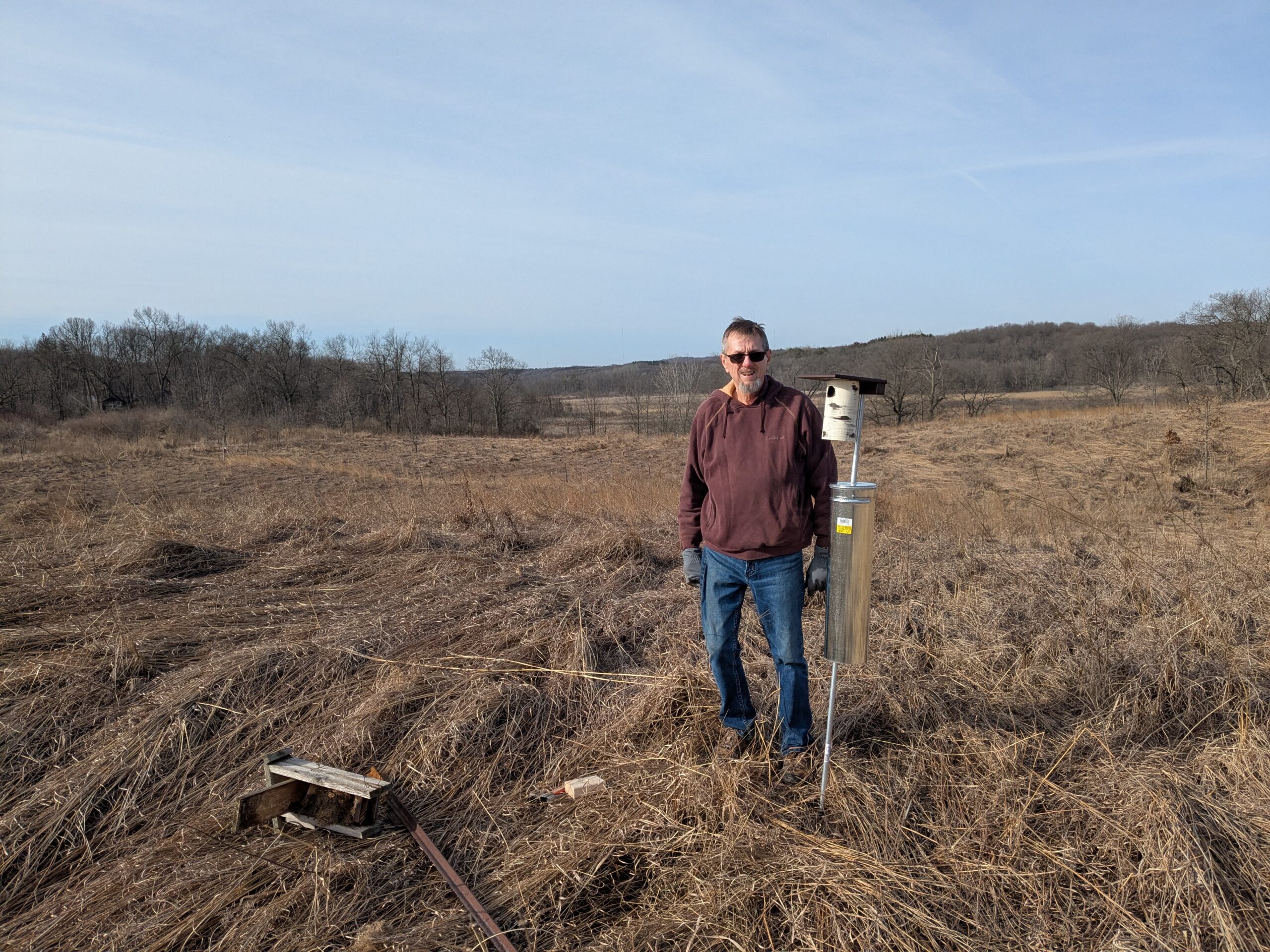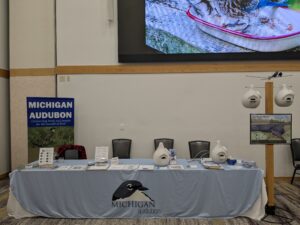Conservation Manager Chad Machinski, M.S., manages the stewardship of MA’s sanctuaries and engaging with our dedicated volunteers ever since. To help you stay connected with the work being done, he will be presenting regular online updates about activities going on at them: birds seen or heard, conservation work, improvements, interesting plants, and more.
It’s been a busy month since my last blog as I juggle getting out into the field with necessary work in the office, all while trying to get a few things done before nesting and growing season begins. I’ve been out to the Phyllis Haehnle Memorial Sanctuary and Capital City Bird Sanctuary (CCBS) twice, Otis Farm Bird Sanctuary, Ronald H. Warner Sanctuary, and Martha Mott Sanctuary once, given one presentation and hosted a table at the Spring Bluebird Festival. Let’s dive in to see what’s what.
SANCTUARY VISITS

Photo of cut Autumn Olive stacked along Snickerdoodle Trail by the main entrance of CCBS. All cut from area to the left of photo. This area had been cleared several years ago and was planted with hawthorns. Photo by Chad Machinski
Despite warm weather popping up over the past month, a warm day at Haehnle continues to elude me and I fear I may never be warm there again. On February 20, Haehnle Committee Chair Steve Jerant and I were joined by three volunteers as we worked through the oak savanna restoration site to nip invasive shrubs that did not get mowed down near larger trees. As a reminder, this area is part of work being funded by the Michigan DNR’s Wildlife Habitat Grant Program and is being distributed to us through the American Bird Conservancy. We will continue to work through these areas to spot-treat invasive forbs and shrubs, so please join us at the Haehnle Sanctuary on the third Thursday of the month to help restore this area to oak savanna! If you can, please RSVP through the Jackson Audubon Society by emailing [email protected]. Also, this past month, Steve Jerant and nest box monitor Alex Johnson were able to get two Wood Duck boxes replaced at the sanctuary thanks to funds from the TC Energy Grant.
This spring, there will also be a prescribed burn at Haehnle of the grassland along Wooster Rd. Stay tuned for updates on that.
At the Martha Mott Sanctuary, we’re back to business as usual, decimating autumn olive on site. On our February 21 workday, eight of us put a dent in the autumn olive between the two meadows, only being halted by the largest few that hand tools couldn’t handle. We’ll be back at it on Friday, March 21, from 1 to 4 p.m. if you would like to join us! One thing to note from my visit on the 21st was the sighting of a male bluebird checking out the inside of nest box MM-10, the box that produced three broods of bluebirds last year. Will MM-10 fledge 10 bluebirds again this year? Only time will tell.
On February 27, I was out at CCBS in Lansing and enjoyed my birdiest (birdy-est?) day of 2025 with 23 species of birds. The Grand River, being unfrozen, produced a handful of Common Mergansers, Hooded Mergansers, and a couple of Common Goldeneyes. While the river was flowing freely, there was still ice around the edges, and one cold-looking Great Blue Heron stood amongst some downed river debris. My next visit on March 13 was the first day of returning volunteers. It was great to see Paul Bielawski and Steve Charteris again after not seeing them since November/December. We got into some young but thick autumn olive that had seen treatment a few years ago but was back with a vengeance. It was around 60F that day, and as I got done hauling autumn olive to the trail’s edge, huffing and puffing, I wondered how I would ever survive the summer when it inevitably gets to 90F!
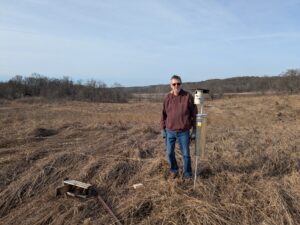
Nest box monitor Scott Evans standing next to recently installed box Otis-GP6 in Unit 2.06. These boxes were purchased through TC Energy Grant. Photo by Chad Machinski
The bluebird at Martha Mott made me realize that it was about time to make sure nest boxes were in the ground, and on March 11, Otis’s nest box monitor Scott Evans and I did just that. We had 10 nest boxes to put in the ground at Otis, all of which would be replacing aging nest boxes. We are trying a different style at Otis and will be running a bit of an experiment as we installed Gilbertson PVC nest boxes but have them paired with a classic style of nest box. The Gilbertson PVC boxes replaced boxes that were unused last year, but were still paired with another nest box. At the end of the season, we’ll see if the PVC boxes get used and used by who. This will show us preference of nest box design, if we need to un-pair nest boxes, or if we are at a saturation point of nest boxes at Otis. I’m excited to see how this season turns out for our bluebirds and Tree Swallows that will be using these boxes.
While out at Otis, I also stopped by our Warner Sanctuary, a mere 5 minutes away, to do a survey of the trails. I was greeted by my first snake of the season, a northern ribbon snake, and got a great look of a Red-shouldered Hawk, the latter of which is usually soaring over Warner Lake, but was perched in an oak near the lake and the main trail. If you head out to Warner for a hike, be aware that the small beaver dam at the south end of Warner Lake has been breached over the top and has put a bit of water over the top of the boardwalk.

Photo of boardwalk south of Warner Lake in Unit W2B. Beaver dam at south of lake has been somewhat breached with water flowing over the top middle. Photo by Chad Machinski
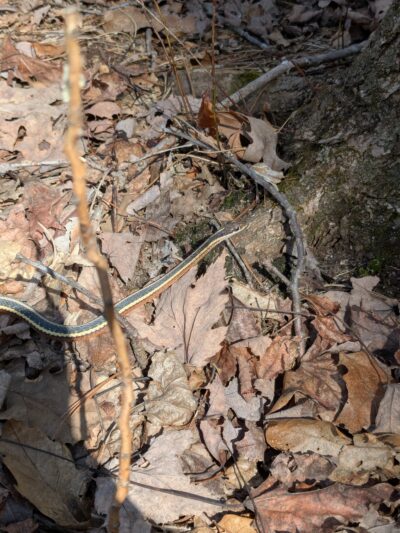
Photo of Ribbon Snake in Unit W1. Photo by Chad Machinski
EVENTS
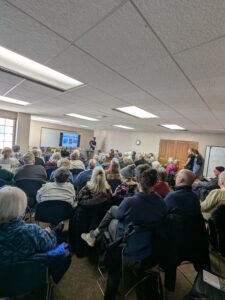
Photo of Chad Machinski giving presentation at Kent District Library with approximately 50 people in attendance. Photo by Murphy Harrington
On Saturday, March 8, I had the pleasure of giving a presentation at the Kent District Library in Lowell on why we should be planting native plants in our gardens to support our native birds. The presentation was well attended and seemed to be well received. I’m pleased to see all the people who are becoming increasingly interested in native plants and supporting our native insects and, thus, our native birds. I want to thank the Lowell Showboat Garden Club for having me!
On March 15, I attended the annual Spring Bluebird Festival at Calvin College, put on by the Michigan Bluebird Society (MBS). I want to thank MBS for inviting Michigan Audubon to have a table at their festival! Purple Martin Landlord Penny Briscoe and I hosted the Michigan Audubon table to talk about cavity-nesting birds that Michigan Audubon is focusing on: Purple Martins and Chimney Swifts. We also distributed booklets on native plants for birds and native plant designs. Like the presentation the week before, it’s great to see that people are increasingly interested in going native with their gardens! I’m also happy to spread more information on Chimney Swifts and Purple Martins. It seems that many people are aware of the existence of Purple Martins as a result of seeing the housing frequently put up near the water and at farms, but fewer people really know details about the Purple Martin itself. I’m always glad to have Penny there, who has been working with Purple Martins for around 40 years now. Speaking of….the day after the festival, Penny had a Purple Martin at her housing which was the earliest Purple Martin arrival she has had in her time working with martins by 10 days. There have been at least two other observations of martins in Michigan since last Thursday, leaving many landlords concerned for Purple Martins that continue to arrive as a stretch of 3-4 days of cold weather can leave them without food (flying insects) and prone to starving to death.
While Purple Martins are arriving, Chimney Swifts are still a ways off, with a scattering of eBird observations in the southern US, the most northern being in Arkansas. While on the topic of Chimney Swifts, the 2025 State of the Birds report has been released, and unfortunately Chimney Swifts have moved from being a Yellow-Alert Tipping Point Species to the more critical Orange-Alert Tipping Point Species. While a litany of issues plague Chimney Swifts, one way you can help us better understand issues with Chimney Swifts is by reporting roosting and nesting sights to Michigan Audubon through our reporting forms and also reporting these along with general sightings to eBird.
If you have made it all the way through this blog, I want to thank you! I know it was a haul.
To learn more about Michigan Audubon sanctuaries, visit michiganaudubon.org/conservation/bird-sanctuaries. If you want to volunteer at a Michigan Audubon sanctuary, please complete the Sanctuary Volunteer Interest Form.

Chad Machinski, MS
Conservation Manager
While Chad’s first love is botany, he doesn’t deny the intertwining nature of birds, plants, insects, and all other organisms we share the world with. His passion for the natural world began in his undergraduate time at the University of Michigan, taking several different forms along the way. His graduate studies at the University of Michigan allowed him to more closely examine the natural communities of Michigan and further understand the complex nature of ecosystems. His work as a Nichols Arboretum Caretaker while in school further enabled him to be directly involved in conservation work as he led workdays removing invasive plant species, performed trail maintenance, and guided tours. Chad can usually be found out in a park in a few ways: binoculars glued to his face, hunched over looking at plants, or flipping logs looking for snakes and salamanders.

